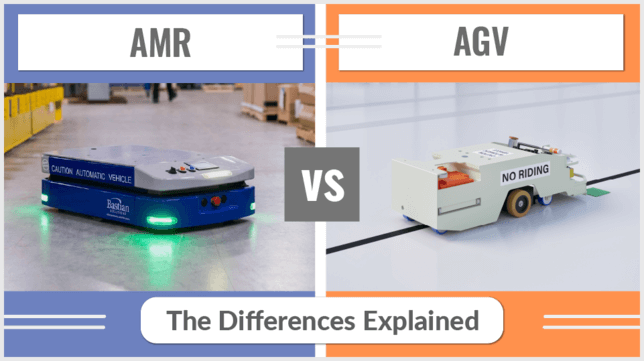This article explains everything you need to know about AGV vs. AMR material handling equipment.
You’ll learn:
-
What AGVs and AMRs are
-
What types of tasks each can perform
-
The average cost of each
-
The benefits you can achieve by using AGVs and AMRs
-
How to decide which one is best for your operation
Let’s dive in!
Quick Summary
Don’t have time to read the whole article? Here’s a quick summary of the main points.
- AGV stands for “automated guided vehicle” and AMR stands for “autonomous mobile robot”
- AGVs are automated material handling equipment that follows predefined paths with limited ability to make real-time corrections to its course
- AMRs are automated material handling equipment that use digital maps or sensors to navigate its environment, while being able to make real-time course correction
- The main types of AGVs include carts, tuggers, forklifts, unit-load, and heavy haul
- The main types of AMRs include those used for picking, inventory management, and sortation
- AGVs are best used in applications where processes and movements change very little
- AMRs are best used in dynamic applications where multiple types of tasks need to be automated
- Both technologies can help operations improve productivity, reduce damage, boost inventory control, cut costs, and improve safety
AGVs: An Overview
What Is An AGV?
First of all, AGV stands for “automated guided vehicle.”
And they are a type of unmanned guided vehicle (UGV) used to automate repetitive tasks, such as hauling raw materials in production facilities.
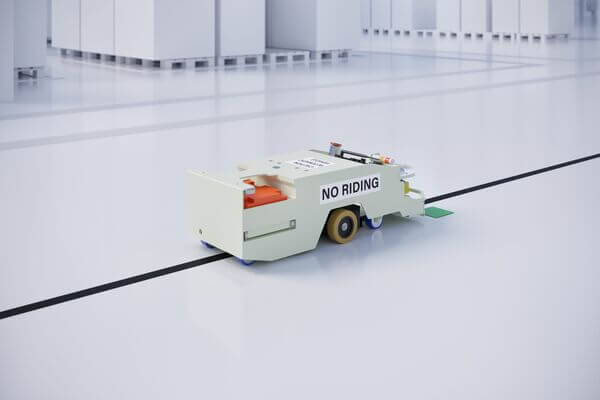
The defining characteristic of AGVs is that they travel on predefined paths using automation software for instructions.
But, they cannot make real-time corrections to their course.
When Were AGVs Invented?
AGVs have been around since the 1950s.
The credit for their invention goes to Arthur Barrett, whose company Barrett Electronics created the “Guide-O-Matic” driverless vehicle in 1954.
These early AGVs were modeled on trains and were usually used to pull carts.
In the 1970s, the “Stop & Drop” AGV came along, which could automatically handle and unload pallets.
From the 1980s onward, much of AGV development has been focused on improving navigational and fuel systems.
What Can An AGV Do?
AGVs are commonly used for transport.
That includes moving raw materials used in production or transferring work-in-progress materials between lines and workstations.
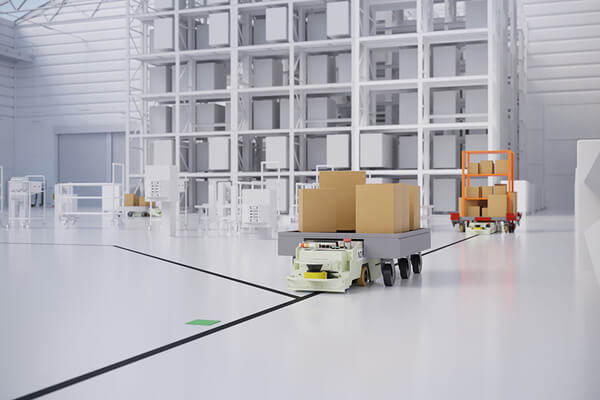
They are also used for picking and storage activities.
For example, warehouses may use AGVs to move inbound materials to storage or retrieve storage items needed to replenish stock.
What Are the Types of AGVs?
One thing that unites all AGVs is that they’re all wheeled vehicles.
That said, they do come in several varieties.
The 5 main types of AGVs are:
- Carts
- Tuggers
- Forklifts
- Unit-load
- Heavy-haul
Let’s go through each.
Cart AGVs
These are the simplest AGV material handling machines.
In essence, they’re low-profile carts with a storage structure mounted on top containing various materials or items.
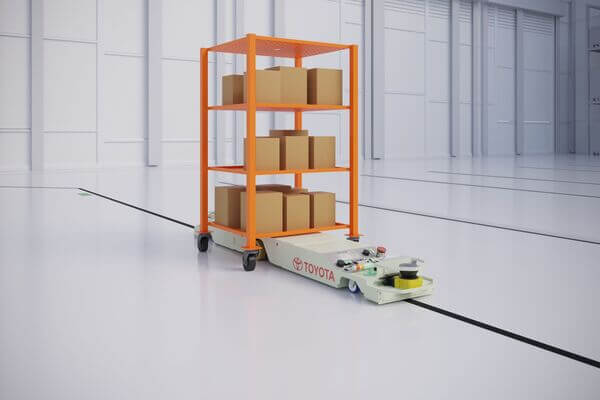
The AGV cart moves around the facility and stops where the materials are needed.
You can find this type of AGV in automotive and E-commerce operations.
Tugger AGVs
If you’re wondering “what is an example of an AGV?”, the most common one you’ll see is the AGV tugger.
These are used to pull non-powered carts with loads up to 50,000 lbs.
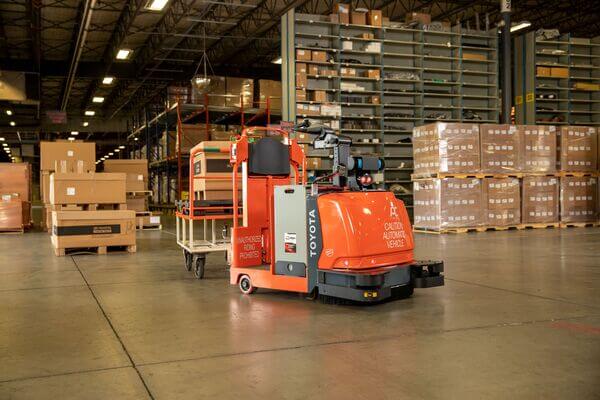
For example, they’re often used to automatically transport heavy machine components, assemblies, and equipment.
Basically, anything that’s too dangerous or difficult to transport manually.
Forklift AGVs
Forklifts can come as – or be converted into – automated guided vehicles.
They’re used to automatically move and stack products like paper rolls, coils, and even vehicles.
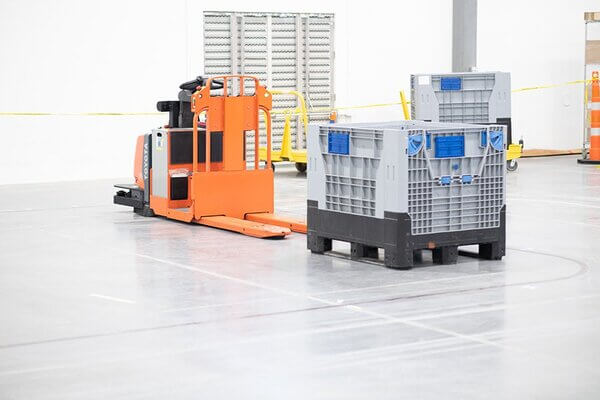
Some examples of forklift AGVs include automated pallet jacks, sit-down counterbalance lift trucks, reach trucks, and narrow aisle equipment.
Unit-Load AGVs
These are individual vehicles automated to transport single products, such as a pallet or a bin containing products.
In a typical application, a unit-load AGV will stop where it needs to be loaded (from an AS/RS system, for example), then move to another spot where the products or materials are needed.
This type of AGV is commonly used in the food and beverage industries.
Heavy-Haul AGVs
Heavy-haul AGVs are the most robust type, featuring sturdy bases, durable wheels, and large platforms, and built to handle up to 250,000 lbs.
They’re used in industries that handle heavy materials, like construction, aviation, and shipbuilding.
Often, they’re custom-designed to fit the application.
Where Are AGVs Used?
AGVs work best in applications where operations are fixed and well-defined.
For example, a factory AGV tugger may be used to move raw materials to replenish stock so a production line can operate uninterrupted.
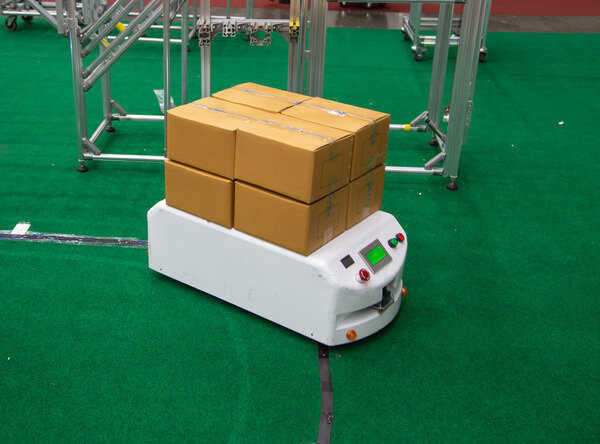
AGVs work well in this application because the process is repetitive and has little variation.
Other industries that use AGVs include:
-
Warehouses and distribution centers
-
General manufacturing
-
Automotive
-
Food and beverage processing
-
Healthcare and pharmaceuticals
-
Packaging, paper, and printing
-
Aerospace
-
Industrial horticulture
-
Mail and newspaper
AMRs: An Overview
What Is An AMR Vehicle?
First off, what does AMR stand for?
AMR stands for “autonomous mobile robot.”
Like AGVs, AMRs are a type of unmanned guided vehicle (UGV).
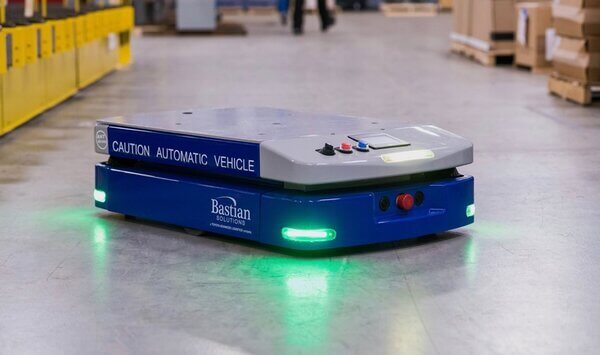
What makes them different from AGVs is that AMRs are not limited to a specific route.
Instead, they can make navigational decisions in real-time without the need for human intervention.
When Were AMRs Invented?
The origins of AMRs can be traced to William Grey Walter.
He developed the first AMR between the late 1940s and early 1950s.
From its conception, it was designed to be used as an assistant in medical research laboratories.
To serve in this capacity, the AMR used light, touch, and sound sensors to detect its environment and make decisions based on the data it received.
AMRs didn’t successfully enter into commercial use until the early 1990s, with the creation of the “HelpMate” robot.
This AMR was used in hospitals to assist staff with activities like serving food trays, delivering mail, and transporting lab results.
Nowadays, AMR technology has advanced, with improvements in sensors, guidance software, and safety systems.
What Can An AMR Do?
Most AMR transport systems are designed to move, load, retrieve, sort, pick, or even stack cases, totes, or carts.
An example of how an AMR might function in a warehouse is as follows:
- Robotic arms, conveyors, or human workers load the AMR with products or materials
- The AMR then automatically moves to its next destination
- There, it deposits its load onto chutes, conveyors, shelving, flow racks, or workstations
All the while, the AMR is continuously updated with information about its surroundings and even inventory changes.
It uses this information to calculate each of its subsequent tasks – along with the shortest route to get to each.
What Are the Types of AMRs?
There are many different AMR designs and models.
But, they can be classified into one of 3 groups, based on the types of tasks that they perform:
- Picking and putting
- Inventory management
- Sortation
Let’s briefly cover each.
Picking or Putting AMRs
Manual order picking is time-consuming.
In fact, it can account for up to 75% of the order fulfillment process.
By automating these tasks with AMRs, operations can save time, cut costs, and increase productivity.
How does an AMR picking assistant work?
The AMR does exactly what a human order picker does.
Namely, traveling between storage and workstations and picking and placing items needed for production, assembly, or shipping.
Thus, they eliminate the need for humans to do the same tasks so they can focus on other value-added activities.
Inventory Management AMRs
Instead of humans walking around and manually checking inventory, AMRs can automatically do it.
For instance, an aerial AMR can track SKUs in real-time using RFID technology and integration with a warehouse management system (WMS).
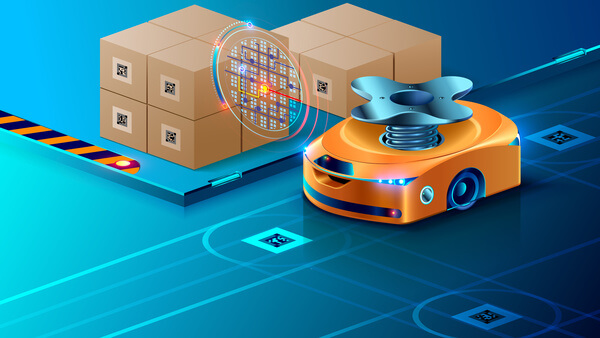
Then, another AMR can be alerted to replenish low stock.
Besides freeing workers from manually-checking inventory, AMR inventory assistants can help managers identify storage areas used inefficiently.
Sortation AMRs
These AMRs direct goods and materials to their next stop.
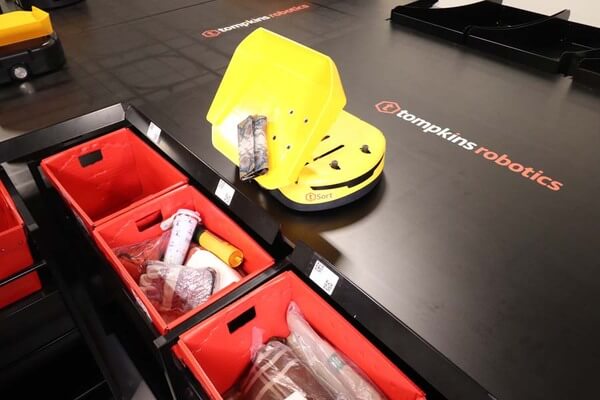
Here’s an example of how the process could work:
- A sortation assist AMR has a tray on top of it
- Either workers or robotic arms place an item on the tray
- The AMR uses a camera to identify the item and where it belongs
- Then, it calculates the shortest path to take
- Finally, the AMR stops at the designated area, tilts its top, and lets the item slide off and down a chute
Where Are AMRs Used?
AMR technology works best in dynamic environments.
That’s because they can respond to changes in tasks and navigation in real-time, unlike AGVs.
Additionally, they’re adept at handling operations with lots of different SKUs and where collaborating with human workers is important.
This makes them perfect for person-to-goods and goods-to-person logistics operations.
Specific AMR applications include:
-
Hospitals
-
Airports
-
Warehouses, particularly e-commerce
-
Hazardous environments, like fire, nuclear, and military
8 Differences Between AMRs and AGVs
Sometimes folks – and even manufacturers – use the terms AMR and AGV interchangeably.
But there are key differences between the two technologies.
Let’s go through those differences.
Navigation
The best way to explain the difference in navigation between an AGV and an AMR is by comparing them to a train and a car.
Trains can only run on rails, of course.

That makes them like AGVs, as they can only follow a predefined path.
Cars, on the other hand, can go pretty much wherever they want.
In that way, AMRs are more like cars (self-driving cars, more specifically).

AMRs don’t need to stick to a predefined path.
Rather, they can navigate between nearly any 2 points while also recalculating and adjusting their route on the fly, such as when there’s dense traffic or obstructions.
But, there’s a bit more to know about AGV and AMR navigation methods.
So let’s dive into each.
AGV Navigation
The main fact to know about AGV navigation is that they use onboard sensors and infrastructure cues to navigate.
Additionally, they are pre-programmed to turn, accelerate, and decelerate on their own.
And while they can detect obstacles, they cannot maneuver around them.
Instead, the AGV will simply stop when it encounters an obstacle but won’t move until the obstacle is physically removed.
How Does AGV Navigation Work?
Wondering “How do automated guided vehicles work?” or “What guides an AGV?”
Answer: Either a wire guidance system or optical sensors.
AGV Wire Guidance
An AGV wire guidance system consists of a wire embedded beneath the floor and sensors on the AGV.
The embedded wire emits electrical signals.
And the AGV’s sensors detect the signals to determine where the path is and how to follow it.
The main drawback of this method is that it’s expensive to install, as it requires digging up the floor to bury the wire.
Not only may the installation be costly, but it can also cause costly disruption to your operation through downtime.
AGV Optical Guidance
In comparison, an AGV optical guidance system uses a variety of environmental cues, such as reflective markers, magnetic strips, or QR barcodes, along with lasers or cameras on the AGV.
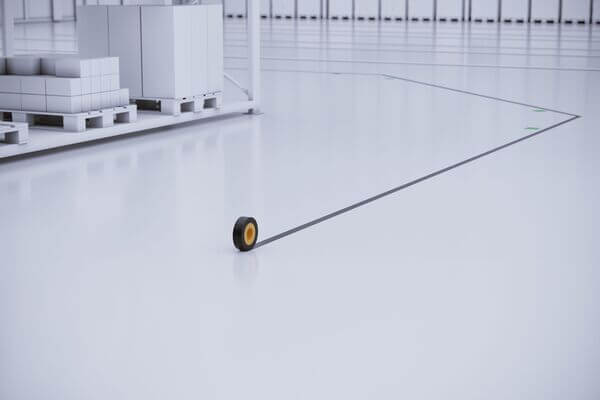
The sensors on the AGV detect the cues and use them to determine its location and direction.
The advantage of optical guidance over wire guidance is that you don’t have to do structural work like digging up the floor and burying a wire underneath it.
Instead, you use adhesives or common mounting methods to install the environmental cues.
AMR Navigation
Instead of using physical cues embedded or installed in the infrastructure, AMRs use sensors and software to understand their environment.
These sensors and detectors can include:
- 3D depth cameras
- LIDAR technology
- Laser scanners
- Simultaneous Location and Mapping (SLAM) technology
The sensors identify both static and dynamic elements in your environment, like pallet racking, people, and other equipment.
Then, the sensors feed the data to the AMR’s software.
The software then does a multitude of things, including identifying obstacles, calculating routes, and tracking inventory changes.
What Is SLAM Technology?
SLAM stands for “Simultaneous Location and Mapping,” and it’s a guidance method sometimes used in AMRs that uses algorithms to localize and map environments.
A SLAM system uses cameras and sensors to create a map of the vehicle’s surroundings (called “mapping”).
It also uses information from the vehicle’s monitoring systems, such as how many revolutions the wheels make, to determine exactly how far to move (called “localization”).
How Does AMR Navigation Work?
There are 2 main methods for AMR navigation.
Method 1: Geo-Guidance
This system is similar to a car GPS with preloaded routes.
To navigate, the AMR uses a map of the facility instead of sensors embedded in the environment.
In using a map, the AMR can determine its place in the environment and find its way around automatically.
The advantage of geo-guidance is that you can quickly and easily modify the map according to changes in your working environment.
Method 2: Laser Guidance
In this guidance method, the AMR uses lasers to scan and detect its environment without the use of a map.
Overall, this is a new but reliable navigational technology, is accurate and easy to use, and makes the AMR completely autonomous.
The downside, however, is that the AMR can get lost in wide-open spaces where it can’t readily recognize its surroundings.
This will shut the unit down and require the intervention of a human worker.
Data Collection & Intelligence
AMRs are smarter and have more robust data collection abilities than AGVs.
In particular, they provide much more information to facility managers, such as data on KPIs.
Let’s go through the differences between AMR and AGV intelligence in more detail.
AMR Data Collection & Intelligence
AMR robotics use Wi-Fi and cloud-based technologies for data collection and storage.
This allows them to collect lots of information for a variety of purposes, such as:
- Updating the facility map with new parameters that it learns during operation
- Tracking individual SKUs
- Coordinating tasks between other equipment
Moreover, AMRs can easily integrate with warehouse management systems (WMS) or warehouse execution systems (WES) to manage the entire order fulfillment process.
AGV Data Collection & Intelligence
AGVs do not collect nearly as much data as AMRs.
Thus, they don’t offer as great insight into your operation.
AGVs can, however, work with technologies like WMS or WES systems – though perhaps not as easily as AMRs in some cases.
But more than anything, AGVs simply do the work they’re assigned and not much else.
Safety
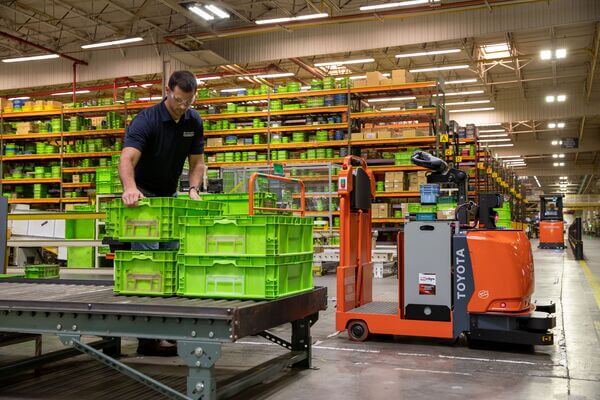
In general, AMRs are safer than AGVs.
Here’s why…
AMR Safety
AMRs have a much more robust ability to identify and avoid objects in their environment, including people, infrastructure, and other equipment.
This makes them suitable for working closely with humans – whether in transit or acting as personal assistants.
Additionally, AMRs usually have warning lights and sound systems, which can alert workers to their presence so they can avoid them.
AGV Safety
AGVs can recognize obstructions – like a worker walking in its path – and stop before striking them.
And like AMRs, they can also be equipped with warning systems to alert workers to their location.
That said, it is generally safer for employees to work around AGVs rather than for AGVs to work around employees.
For instance, employees should be instructed to avoid walking along the magnetic tape that guides AGVs.
Load Handling
AGVs tend to have more robust load-handling capabilities.
Let’s explain why.
AGV Load Handling
First, AGVs can move both horizontally and vertically, like a forklift.
This allows them to be used for handling pallet-sized loads.
So, if you need to retrieve pallets from warehouse racking, an AGV may be your best bet.
Secondly, AGVs can handle much more weight than AMRs.
In fact, some models can handle up to 250,000 lbs.!
AMR Load Handling
Like AGVs, some AMRs can be used both horizontally (i.e. transporting goods across the floor) and vertically (i.e. placing goods in shelving or racking).
But, they have much less weight-handling capacity.
How much weight can an AMR handle?
Most AMRs only handle up to 500 lbs., but the maximum is about 2,600 lbs.
Setup
AGVs are more expensive to set up than AMRs.
Here’s why:
AGV Setup
AGVs require infrastructure modification such as installing magnetic tape, burying wire, or adhering barcodes to the floor.
This not only costs money to set up and the services of a specialist engineer, but it may also be costly in production downtime.
AMR Setup
Unlike AGVs, AMRs require no modifications to a facility’s physical infrastructure.
That is, there’s no need for wires, magnetic strips, or any other modifications.
That makes AMRs easy and quick to deploy.
Plus, implementing them causes very little disruption to your operations.
Costs

AMRs generally are more expensive than AGVs.
Let’s discuss why and how much each costs.
AMR Costs
AMRs handle a lot more information and execute more complex tasks than AGVs.
Thus, they require more complicated software, which makes them more expensive.
Moreover, AMR costs are tied to their size and load capacity.
The larger or more complex they are physically, the more money they cost.
But in the long run, AMRs are cheaper than AGVs.
Why?
The biggest reason is that you don’t need to modify and maintain your infrastructure for them to navigate.
How Much Does an AMR Cost?
A small AMR may cost $25,000 to $40,000.
For example, an AMR using the SLAM navigation method can cause between $25,000 and $30,000.
AGV Costs
While having a lower initial cost than AMRs, AGVs do require the installation of physical guides, surface tape, or under-floor wiring.
Besides installation, it’s important to consider other costs such as setup, deployment, reconfiguration, and operation costs.
One way to help ease the capital burden is by leveraging leasing options.
Another option is to use a Robots-as-a-Service (RaaS) model with a monthly subscription.
As far as return on investment, AGVs take longer than AMRs – usually 1+ years.
How Must Does an Automated Guided Vehicle Cost?
AGV prices start at around $15,000 (for models that navigate using magnetic tape).
For example, an AGV tow tractor may cost around $30,000, while an AGV pallet jack can cost $60,000.
How Much Does an Automated Forklift Cost?
An automated forklift can cost between $50,000 to $75,000
By comparison, normal forklifts typically cost between $20,000 and $50,000.
Maintenance
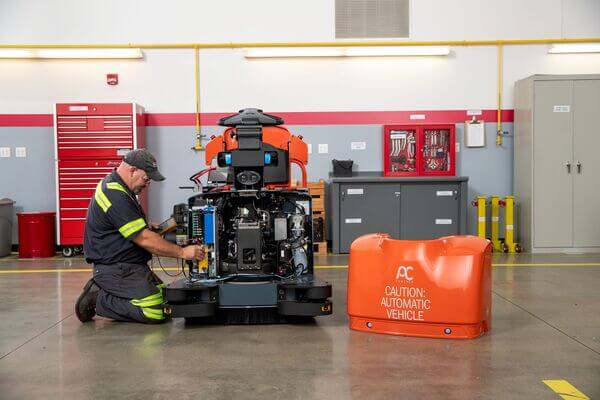
AGVs cost more in maintenance than AMRs do.
Let’s cover everything you need to know about AGV vs. AMR maintenance.
AGV Maintenance
AGV maintenance costs more than AMR maintenance because the physical markers, like magnetic tape and barcodes, are prone to damage from traffic.
So, you need to maintain them regularly to avoid rendering the AGV useless.
AMR Maintenance
Conversely, there’s virtually no infrastructure required for AMRs to operate.
Thus, there’s not much to maintain beyond the normal maintenance items required of both AGVs and AMRs.
That includes lubricating moving parts, replacing worn parts, etc.
Versatility & Scalability
The advantage of scalability goes to AMRs.
Let’s explain why that is, compared to AGVs.
AMR Versatility & Scalability
AMRs are a better choice when there are changes in operations or production workflows.
That’s because you can quickly add a new facility layout (geo-guidance) or allow the unit itself to map the area (laser-guidance).
Additionally, AMRs can adjust to new tasks on the fly.
So, workers don’t have to spend much time coordinating AMR activity, which allows them to focus on other tasks.
And when it comes to scaling your operations, AMRs are much easier to expand than AGVs.
For one, you can deploy AMR fleets in a modular fashion, which allows you to conserve initial capital until you gain proof of concept
For another, you can easily add more AMRs without the need to outsource the installation to 3rd party vendors for changes or additional implementation.
After all, they don’t require infrastructure renovations, facility replanning, or additional training of employees.
AGV Versatility & Scalability
If you need to adjust the path or tasks for an AGV, you’ll need to install new environmental cues like magnetic tape or underground wire guidance systems.
And it’s the same thing if you want to add additional AGV units to your workflow.
This means a lot more is involved – in both costs and disruptions – than for AMRs.
5 Benefits of AGVs and AMRs
There are some definite benefits to using either AGVs or AMRs, or even a combination of both.
The following are some of the key ones.
Improved Productivity
Both autonomous systems help minimize travel time, provide for more efficient scheduling of deliveries, and help reduce bottlenecks.
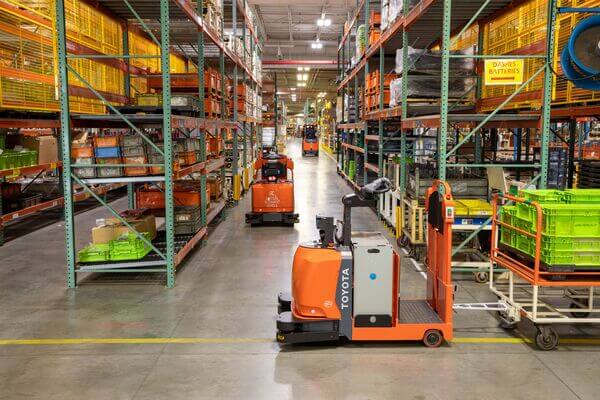
AMRs, in particular, help reduce labor by assisting human workers with tasks such as inventory management, picking, putting, and transporting goods.
These benefits help to allow employees to use their time to focus on higher-value activities.
Reduced Damage
With both AGVs and AMRs, their speed, motion, and movement are carefully controlled.
Each uses an array of sensors, which makes them less likely to collide with people, equipment, and infrastructure.
Plus, they reduce the chances of product damage, which helps preserve your bottom line.
Better Inventory Control
Even though AGVs lack some of the more robust inventory management capabilities of AMRs, they both can help you get and keep a good grip on inventory.
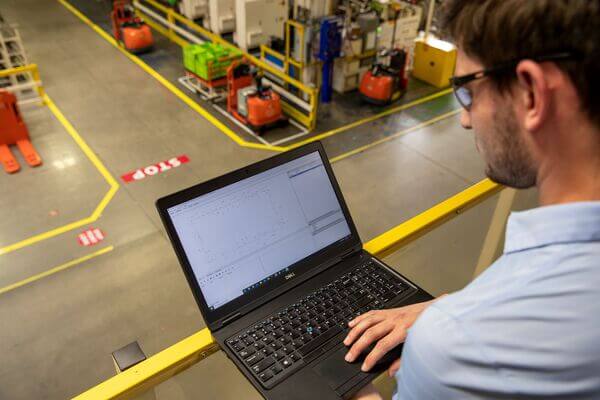
For one, they help minimize errors associated with humans performing the same tasks.
Two, their movements are constantly tracked and controlled, which affords greater inventory accuracy.
And three, both technologies can integrate with warehouse automation and warehouse management systems (WMS) to track inventory levels.
Cost Savings
AGVs and AMRs can both work nonstop, unlike human beings.
Thus, they help cut costs by reducing reliance on expensive and hard-to-source labor.
This means fewer costs in the form of wages, benefits, training, and insurance.
And compared to traditional fixed automated systems, like conveyors and sortation devices, AMRs and AGVs have lower initial costs, take up less space, and take less time to implement.
In fact, AMRs can get up and running in as few as a couple of weeks, whereas conveyor systems may take a year or more before they’re ready to work.
Finally, AGVs and AMRs can operate in dark environments, unlike humans.
So, you can help reduce your utility bills.
Better Safety
Human workers get fatigued, make mistakes, are prone to injury, and get distracted.
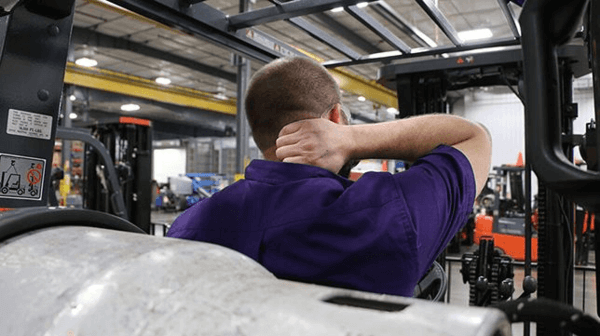
AMRs and AGVs help improve safety by removing the human factor.
For instance, each technology can help reduce worker injuries associated with physical tasks like picking up heavy items.
How to Choose Between an AGV and AMR
Let’s go through 3 important factors you should consider.
What Kind of Loads Do You Handle?
AMRs are less accommodating to larger loads than AGVs are.
So, if you need to handle large (500+ lbs.) loads or pallets, you may want to consider an AGV.
Another consideration is the types of movements you’ll need to make.
For example, will you need to load pallets into pallet racking?
If that’s the case, you may also want to consider an AGV.
After all, AGVs tend to have more robust weightlifting capacities (though AMRs are catching up!).
How Dynamic Is Your Operation?
Recall that AMRs are ideal for more dynamic work environments.
That’s because they can respond and adjust their activities and movements in real-time based on changes detected in the environment.
So, if your operation is constantly changing, such as is the case with airports, hospitals, etc., AMRs may be a better fit.
On the other hand, if your operations are fixed, it may be better to consider an AGV.
For instance, say you’re in a manufacturing facility with fixed storage areas and production lines.
In that case, you may not have much variance in what needs to be done:
Materials must be moved from a fixed storage spot to a fixed production line, finished products moved to staging, and so on.
AGVs work well in this context, while also sparing you the higher upfront cost that comes with AMRs.
What Is Your Business’s Growth Outlook?
Piggy-backing off the last consideration, think about how you expect your operations to grow.
If you’re in E-commerce warehousing, you can obviously expect some growth.
In those cases, AMRs tend to be easier to acquire and implement than AGVs.
On the other hand, if you expect fairly steady and predictable growth, AGVs may be a more financially-sound and effective solution.
There’s a lot that goes into choosing between an AGV and AMR.
We recommend reaching out to experienced professionals when trying to make a decision.
Conclusion
That’s it: The differences between AGVs vs. AMRs.
